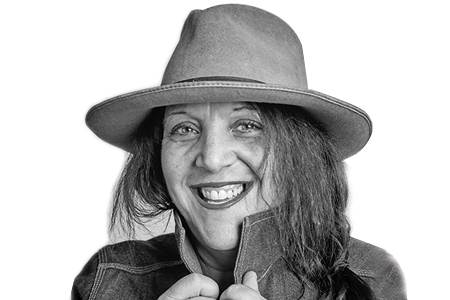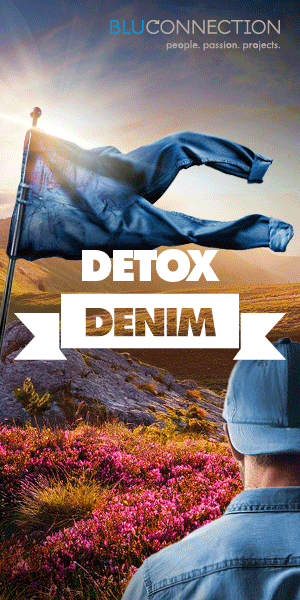Christine Rucci – A True Blue

Denim expert Christine Rucci has first hand experience working with the biggest names in the industry. Next year, she will be celebrating 40 years in the business of making jeans. In her consulting and mentoring activities, as well as in her everyday life, she emphatically upholds rigorous sustainable practices. The ‘godmother of denim’ also supports and fosters American-made jeans.
Q Are you preparing anything special to celebrate your 40 years in the denim industry?
A I am working on my autobiography, From the Bean to the Jean. It will highlight the main events of my career that goes back 40 years, when I first started working for Adriano Goldschmeid at Genius Group. But it goes back even further, making jeans is literally in my genes. My great grandmother, an Italian immigrant, was a seamstress in the garment district in New York, and I designed my first pair of jeans when I was only ten years old. My hope is that my experience, as a woman in a male-dominated industry, will inspire other women, as well as non-binary persons, who seek to build a career in this sector.
You have worked for brands based in all parts of the world, in Europe, the United States and in Asia. What do you see as the key differences between these markets?
There is a common denominator in the jeans business across all regions of the world, but there are also distinct differences in the details. In Asia, the Chinese market has its own styles; the Korean and Taiwanese markets are similar, and Japan is a whole other story. The US is really all about five pocket jeans. And in Europe there are more of what I call ‘tricked out’ jeans.
With regards to jeans design and trends, workwear-inspired utilitarian styles are making a comeback. Is this an important trend for you and how do you see it evolving?
The workwear trend is really interesting, and could be a path to better practices. Take the chore coat, it was designed for form and functionality. Paired with overalls or carpenters, it made workers look like they were wearing a denim suit. And take the blanket-lined jean jacket, born out of cowboys’ need to be warm on the range, it confirms the adage that necessity is the mother of invention.
One evolution I see that exasperates me is the trend to make lighter weight denim fabrics. They don’t last. When they are lasered, they are further weakened. This trend is just creating more waste.
Workwear is made from sturdy fabrics that last. I prefer working with branded fibres, because they are made by companies that do their research. The first step in developing more sustainable collections is to choose a quality fabric and combine that with cleaner finishing. What’s also important to me is to exhaust a fabric. A single reference should be used to make twenty different products. This is better for mills, too, as it simplifies their operations.
Are there any recent developments in fibres, pro- cesses or technologies that have caught your eye?
I am a textile chemist geek, and I focus on facts. Many denim mills are integrating new fibres and technologies, and this is good. The problem is that, very often, their customers are only interested in the bottom line, the price, and many of these innovative and better solutions never make it to market. I believe that if everyone bought premium jeans made from quality denims, their price would go down. And this is what we should all be focusing on.
For added comfort, an essential feature for many consumers, using Tencel can be a good option. The new Lycra Adaptiv is a great solution as it allows the body to expand. I’m happy to see recycled elastane come to market, and the natural indigo that Sarah Bellos is producing at Stony Creek Colors.
Everyone talks about sustainability but there is usually little real action on the ground; what do you see as the most pressing issue, and what is your advice for brands?
The single most critical issue in my opinion is overproduction. Do brands really need to offer hundreds of stock keeping units (SKUs)? Mills too are guilty of this. When they develop 100 new references, there are usually only ten that will sell well.
I am also tired of seeing brands develop “sustainable” capsule collections alongside hundreds of SKUs that continue to pollute. When brands test a single sustainable reference and continue to make 200 conventional styles, they are not addressing the real issue at hand. All that money could be put to better use.
Excess inventory is a recent issue, because back in the day, we would refurbish unsold goods. We would rework them, overdye them, embroider them; jeans that don’t sell can also be lasered.
The industry also needs to keep in mind that sustainability is not only about fibre choice but also covers socio-economic issues, working conditions and human abuse. Too often, it is all smoke and mirrors.
What projects are you working on now that you can tell us about and that illustrate where the industry should be focusing its efforts?
I am currently working with four women denim designers who are all launching new brands that specifically address women’s needs. I’ve tapped my network to have the products made in the United States. I talked Mount Vernon Mills, in Georgia, into making smaller runs for us. It is the oldest mill in the US and it makes fabrics for workwear, the military and denims. It is the company that makes Wrangler’s legacy broken twill. Its archives are a treasure trove.
For finishing, we will be working with Star Fades International in Los Angeles. This laundry has accepted small lots, and the products will be ozone faded. This works also because I can bring four new clients to a single vendor. Small brands and companies need a godmother, and that’s why I am called the godmother of denim.
My goal is to support small and local businesses. For the bigger brands that seek to hire my services, I consider that they are lucky if I agree to work for them. Everything I do is totally transparent, and research based. All my clients must be plastic-free for packaging and shipping. We need to avoid single use plastics and switch to bio-compostable materials made from agricultural waste.
You feel strongly about ethical manufacturing, how do you further this agenda in your work?
I believe in Made in America. My company Godmother NYC Inc was approved for a new grant programme for women-owned businesses and my hope is to make New York a denim-making hub, as it used to be. In the 1980s, it was where most of the premium or fashion jeans were manufactured. Before the 1980s, there were 10,000 contractors in the city, only 78 are left today. When the industry started to offshore production in the late 1980s, it threw the baby away with the bathwater. The big brands played a major role in decimating the US denim industry. Now we need to rebuild the supply chain. Sometimes I feel like I am the Norma Rae of denim.
I seek to avoid what I call washer’s remorse; acid wash for instance, is the worst. Sand blasting too. But why wash down? Heavy washing ruins the fibre. My ethos is less is more.
As much as is possible, I make the brands I work with produce their products in factories that reclaim their water. I appreciate that laser finishing helps save water, but it requires a lot of energy, and it is an expensive technology that not all mills can afford. It begs the question: why do we need to make our jeans look old? I always say you ‘grow’ a pair of jeans, every sign of wear is uniquely yours.
In your teaching and mentoring, what are you telling the next generation of denim industry professionals?
I dedicate 10% of my time to mentoring young designers who cannot afford my services. The Gen Z and Millennials often don’t have a clue about all the processes in making jeans. I recommend that young people who want to be good designers start by working in a factory, that is where they will learn the most.
On a personal level, what do you feel is important and what’s next for you?
My plan is to go back to school. When I went to Italy to work for Adriano in Italy, I never ended up graduating from college. I’d like to get a degree in fashion journalism and in sustainability. I’m also launching a podcast. The first episode features Adriano.
On a personal level, I am a tree steward, I take care of 40 trees in the city. In everything I do, I seek to lighten my own carbon footprint. I buy local. The food I purchase comes from a local farmers’ market. I never buy online. But if I have to, it has to be from a small business. If I had just one thing to say, I’d say shop small!
Christine Rucci’s résumé reads like a who’s who of the world of denim. She began her career working for the Rosen family, who sent her to Italy to learn the ropes with Adriano Goldschmeid and Renzo Rosso at the Genius Group. Back in the US, still with the Rosens, she had a hand in making jeans for Calvin Klein Jeans and Marithé + François Girbaud, and later for Donna Karan, Tommy Hilfiger and Ralph Lauren, where she would become the senior design director for Double RL. Through her consultancy, Godmother NYC, she continues to work for leading companies but also dedicates her energy and efforts to giving a helping hand to the next generation of denim designers.
Photo: Mark Adams Pictures













